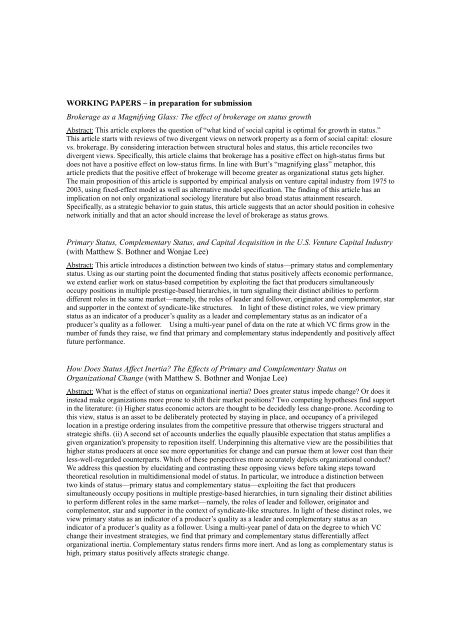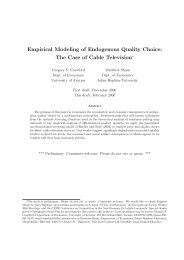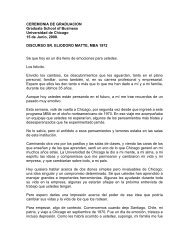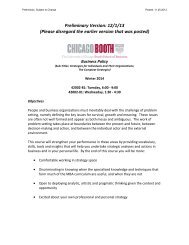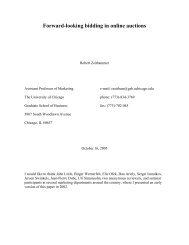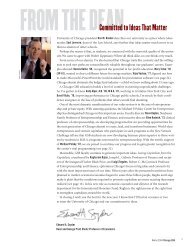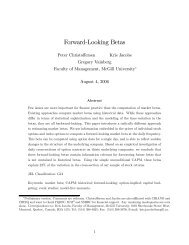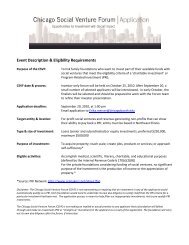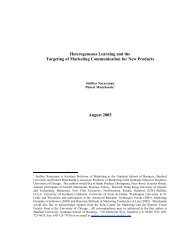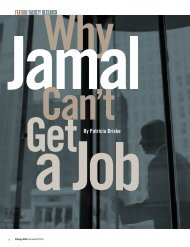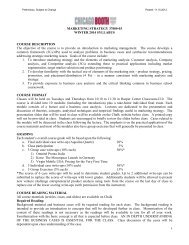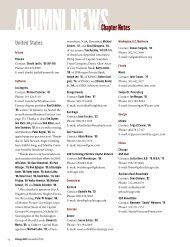Young-Kyu Kim - The University of Chicago Booth School of Business
Young-Kyu Kim - The University of Chicago Booth School of Business
Young-Kyu Kim - The University of Chicago Booth School of Business
You also want an ePaper? Increase the reach of your titles
YUMPU automatically turns print PDFs into web optimized ePapers that Google loves.
WORKING PAPERS – in preparation for submissionBrokerage as a Magnifying Glass: <strong>The</strong> effect <strong>of</strong> brokerage on status growthAbstract: This article explores the question <strong>of</strong> “what kind <strong>of</strong> social capital is optimal for growth in status.”This article starts with reviews <strong>of</strong> two divergent views on network property as a form <strong>of</strong> social capital: closurevs. brokerage. By considering interaction between structural holes and status, this article reconciles twodivergent views. Specifically, this article claims that brokerage has a positive effect on high-status firms butdoes not have a positive effect on low-status firms. In line with Burt’s “magnifying glass” metaphor, thisarticle predicts that the positive effect <strong>of</strong> brokerage will become greater as organizational status gets higher.<strong>The</strong> main proposition <strong>of</strong> this article is supported by empirical analysis on venture capital industry from 1975 to2003, using fixed-effect model as well as alternative model specification. <strong>The</strong> finding <strong>of</strong> this article has animplication on not only organizational sociology literature but also broad status attainment research.Specifically, as a strategic behavior to gain status, this article suggests that an actor should position in cohesivenetwork initially and that an actor should increase the level <strong>of</strong> brokerage as status grows.Primary Status, Complementary Status, and Capital Acquisition in the U.S. Venture Capital Industry(with Matthew S. Bothner and Wonjae Lee)Abstract: This article introduces a distinction between two kinds <strong>of</strong> status—primary status and complementarystatus. Using as our starting point the documented finding that status positively affects economic performance,we extend earlier work on status-based competition by exploiting the fact that producers simultaneouslyoccupy positions in multiple prestige-based hierarchies, in turn signaling their distinct abilities to performdifferent roles in the same market—namely, the roles <strong>of</strong> leader and follower, originator and complementor, starand supporter in the context <strong>of</strong> syndicate-like structures. In light <strong>of</strong> these distinct roles, we view primarystatus as an indicator <strong>of</strong> a producer’s quality as a leader and complementary status as an indicator <strong>of</strong> aproducer’s quality as a follower. Using a multi-year panel <strong>of</strong> data on the rate at which VC firms grow in thenumber <strong>of</strong> funds they raise, we find that primary and complementary status independently and positively affectfuture performance.How Does Status Affect Inertia? <strong>The</strong> Effects <strong>of</strong> Primary and Complementary Status onOrganizational Change (with Matthew S. Bothner and Wonjae Lee)Abstract: What is the effect <strong>of</strong> status on organizational inertia? Does greater status impede change? Or does itinstead make organizations more prone to shift their market positions? Two competing hypotheses find supportin the literature: (i) Higher status economic actors are thought to be decidedly less change-prone. According tothis view, status is an asset to be deliberately protected by staying in place, and occupancy <strong>of</strong> a privilegedlocation in a prestige ordering insulates from the competitive pressure that otherwise triggers structural andstrategic shifts. (ii) A second set <strong>of</strong> accounts underlies the equally plausible expectation that status amplifies agiven organization's propensity to reposition itself. Underpinning this alternative view are the possibilities thathigher status producers at once see more opportunities for change and can pursue them at lower cost than theirless-well-regarded counterparts. Which <strong>of</strong> these perspectives more accurately depicts organizational conduct?We address this question by elucidating and contrasting these opposing views before taking steps towardtheoretical resolution in multidimensional model <strong>of</strong> status. In particular, we introduce a distinction betweentwo kinds <strong>of</strong> status—primary status and complementary status—exploiting the fact that producerssimultaneously occupy positions in multiple prestige-based hierarchies, in turn signaling their distinct abilitiesto perform different roles in the same market—namely, the roles <strong>of</strong> leader and follower, originator andcomplementor, star and supporter in the context <strong>of</strong> syndicate-like structures. In light <strong>of</strong> these distinct roles, weview primary status as an indicator <strong>of</strong> a producer’s quality as a leader and complementary status as anindicator <strong>of</strong> a producer’s quality as a follower. Using a multi-year panel <strong>of</strong> data on the degree to which VCchange their investment strategies, we find that primary and complementary status differentially affectorganizational inertia. Complementary status renders firms more inert. And as long as complementary status ishigh, primary status positively affects strategic change.


